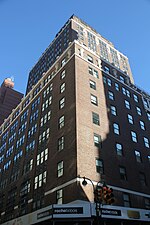Science, Industry and Business Library

The Science, Industry and Business Library (SIBL) was a research library of the New York Public Library (NYPL) system in Midtown Manhattan. SIBL was created in 1996 when materials relating to science, business, and related fields were relocated from the Main Building (now the Stephen A. Schwarzman Building) to a new branch was located within the former B. Altman and Company Building. The SIBL branch entrance was on Madison Avenue between 34th and 35th Streets. The branch consisted of space on two levels: street level and one level below ground. In 2016, the NYPL announced that the SIBL would close after the completion of an upcoming renovation of the Mid-Manhattan Library. The Mid-Manhattan Library, which reopened in 2020 as the Stavros Niarchos Foundation Library, contains a business center that replaces the SIBL's collection.
Excerpt from the Wikipedia article Science, Industry and Business Library (License: CC BY-SA 3.0, Authors, Images).Science, Industry and Business Library
Madison Avenue, New York Manhattan
Geographical coordinates (GPS) Address Nearby Places Show on map
Geographical coordinates (GPS)
| Latitude | Longitude |
|---|---|
| N 40.7481 ° | E -73.9831 ° |
Address
Madison Avenue 198
10016 New York, Manhattan
New York, United States
Open on Google Maps




